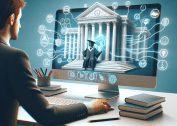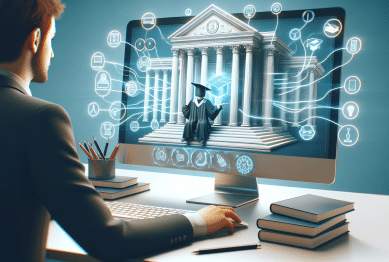Discover how digital classrooms are reshaping modern education. This guide explores virtual learning environments, online tools, interactive teaching methods, and digital literacy essentials, revealing ways students and teachers adapt for deeper engagement and stronger outcomes.
Unlocking Digital Classrooms for Modern Learners
When exploring the landscape of digital education, the concept of the digital classroom has grown from a niche innovation to a core pillar in today’s academic world. Virtual learning platforms now anchor daily routines for many students and teachers, enabling learning anywhere with a reliable device and internet access. Learners harness educational apps, collaborative spaces, and cloud-based materials to enhance their academic experiences. This shift is not simply about using a computer for lessons—it’s about creating spaces that connect people, ideas, and resources globally, offering flexibility that traditional classrooms can rarely match (Source: https://www.ed.gov/oii-news/digital-classrooms).
Students and educators adapt quickly to technologies that foster both independent study and teamwork in real time. With live-streamed lectures, discussion boards, and digital whiteboards, pupils can interact, ask questions, and participate in project-based learning regardless of their location. Today, a math lesson can begin in a video meeting, then continue in a shared online worksheet, and finally wrap up with feedback given via secure classroom portals. Many schools use learning management systems (LMS) to streamline assignments and monitor progress, which helps bridge gaps for at-risk learners or those managing unique needs.
Despite early skepticism from traditionalists, recent studies show that digital classrooms can boost engagement, especially for those comfortable with technology. Learning online isn’t always easier, but it can be more flexible and personal. For educators, robust analytics tools offer new insights into student performance, making it easier to individualize support. As more institutions move toward blended learning—where in-person and online education merge—digital literacy becomes a prerequisite for success, both in academia and in professional life later on (Source: https://www.brookings.edu/articles/transforming-education-through-technology/).
Virtual Learning Environments: Beyond the Traditional Classroom
Virtual learning environments, or VLEs, are changing how knowledge is delivered and received. These platforms allow educators to create dynamic curriculums that integrate text, video, simulations, and interactive activities. Students can pace their learning, pause to revisit concepts, or jump ahead as confidence grows. VLEs often include tools for quizzes, instant messaging, and collaborative editing, enhancing participation and self-guided research (Source: https://edtechmagazine.com/k12/article/2021/05/why-schools-should-embrace-virtual-learning-environments).
These environments are not limited by four walls or a single time zone. Global classrooms can bring together learners from diverse backgrounds, promoting richer cultural understanding and debate. Teachers can invite guest speakers from anywhere in the world via video link, expanding perspectives and making once-rare educational opportunities more accessible. Peer collaboration, meanwhile, shifts toward group wikis and shared cloud folders, encouraging ongoing discussion and creative teamwork. The boundaries that restrict traditional classes dissolve in the VLE model.
Schools that adopt these virtual platforms report improvements in attendance and motivation, particularly among students with alternative learning needs. Missed classes might become recorded lessons, reducing knowledge gaps. Participating in forums and digital group activities builds community among remote learners, who may otherwise feel isolated. The key is intentional design—educational technology should empower everyone, not add complexity or obscure core lessons.
Digital Literacy: The Essential Skill for the Future
Digital literacy is now as important as reading and mathematics. At its core, digital literacy means being able to safely and effectively navigate digital tools, information, and communication systems. In a digital classroom, students learn to evaluate sources, distinguish credible information from unreliable data, and manage privacy settings on various platforms. These competencies are essential for academic research, job preparedness, and even everyday decision-making (Source: https://www.ala.org/advocacy/digital-literacy).
Teachers integrate digital literacy lessons seamlessly into daily learning. For example, a social science project might require students to gather data using professional databases, analyze it in spreadsheets, and present findings through digital storytelling apps. By blending technical skills with creative thinking, learners can produce, critique, and share content confidently. This approach gives them practical skills for future workplaces, where digital fluency is highly valued. At the same time, guidance around cybersecurity helps protect personal information and promotes safe, ethical online behavior.
Digital literacy also reduces inequality by leveling the academic playing field. Schools offering targeted support can help those with limited prior exposure to technology catch up. Community workshops, library programs, and free online resources widen access to skills that foster both confidence and curiosity. As society relies more on digital services, digital literacy becomes a lifelong journey, not just a classroom checkpoint. Adapting to new tools and evolving online norms will remain vital for both teachers and students.
Interactive Teaching Methods in Online Learning
Interactive teaching methods bring lessons to life in digital spaces. Gamification, for example, uses points, badges, or challenges to encourage progress and friendly competition. Students often stay more focused when they receive instant feedback through online quizzes or interactive simulations. Digital storytelling—where students use multimedia to narrate lessons—boosts engagement and memory retention (Source: https://www.edutopia.org/article/5-ways-use-technology-interactive-lessons).
Collaborative projects, such as building presentations in shared cloud documents or participating in moderated online debates, allow learners to develop critical thinking and teamwork skills. Instant polls, breakout discussion rooms, and virtual role-playing exercises help students express different viewpoints or test real-world scenarios in a low-stakes setting. For educators, these approaches offer better insights into participation rates and group dynamics, allowing quick adaptation to students’ needs.
Live polling and audience response tools can turn even large webinars into interactive experiences. By blending formats—such as mixing short lectures with hands-on activities—teachers keep students involved and energized. This active learning model appears to maximize retention compared to more passive approaches. Plus, students gain confidence using the tools and strategies they’ll encounter in digital-first workplaces, making the skills directly transferable beyond school.
Challenges and Opportunities in Access and Equity
Despite its promise, digital education still faces serious access and equity issues. Not every household has a reliable internet connection or device for each learner. Some rural or low-income communities remain underserved, creating a “digital divide” that influences academic achievement and future opportunity. Schools must work with policymakers, nonprofits, and tech providers to close gaps by loaning devices, upgrading infrastructure, or offering accessible Wi-Fi options (Source: https://www.pewresearch.org/internet/2021/06/22/the-internet-and-the-pandemic/).
Language barriers, special needs, and family support structures all affect digital learning experiences. Customizable platforms can adjust text size, enable screen readers, translate materials, or allow content delivery in different formats. Community partnerships and after-school help lines can also bridge gaps. Teachers adapt by providing multiple ways to access materials and connecting students to free or low-cost digital literacy programs in their city.
Overcoming these challenges requires ongoing attention and creative solutions. Parent workshops, local initiatives, and government grants can fund home internet or provide critical training. Leveling the field does more than boost test scores; it gives all students a fair shot at rich, future-ready learning experiences. Improving equity benefits entire communities as digital skills circulate more widely.
Preparing for a Hybrid Future: Blended Learning Models
The rise of digital classrooms has ushered in new models that mix face-to-face and online learning. Blended classrooms might involve interactive group work in person, followed by independent online assignments and feedback. This approach combines the social elements of traditional education with the flexibility and personalization of remote access. Early findings suggest students in blended models often show better engagement and memory retention compared to either format alone (Source: https://www.britishcouncil.org/school-resources/find/blended-learning-benefits).
Teachers gain flexibility, too. Lesson plans can evolve based on immediate feedback from online assessments, allowing for quick pivots to address gaps. Students learn to manage their own time, set goals, and access multiple resources—key skills for careers in any field. Blended learning creates a networked community of learners and teachers who share materials, collaborate across campuses, and help each other navigate both challenges and opportunities.
The future likely lies in hybrid solutions that adapt to unique needs. As schools and families plan for ongoing change, blended models can offer stability, resilience, and lasting benefits. These strategies will remain invaluable as technology continues to transform not just education, but the wider social landscape.
References
1. U.S. Department of Education. (n.d.). Digital Classrooms. Retrieved from https://www.ed.gov/oii-news/digital-classrooms
2. Brookings Institution. (n.d.). Transforming education through technology. Retrieved from https://www.brookings.edu/articles/transforming-education-through-technology/
3. EdTech Magazine. (2021). Why Schools Should Embrace Virtual Learning Environments. Retrieved from https://edtechmagazine.com/k12/article/2021/05/why-schools-should-embrace-virtual-learning-environments
4. American Library Association. (n.d.). Digital Literacy. Retrieved from https://www.ala.org/advocacy/digital-literacy
5. Pew Research Center. (2021). The Internet and the Pandemic. Retrieved from https://www.pewresearch.org/internet/2021/06/22/the-internet-and-the-pandemic/
6. British Council. (n.d.). What is blended learning and what are its benefits? Retrieved from https://www.britishcouncil.org/school-resources/find/blended-learning-benefits









